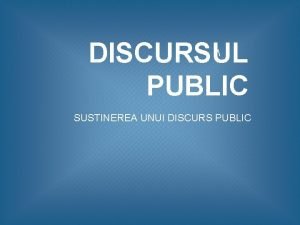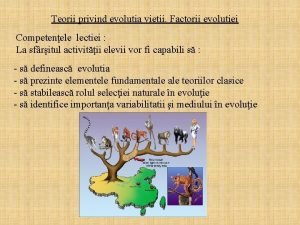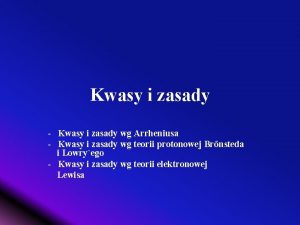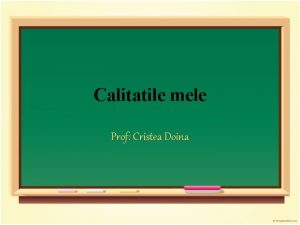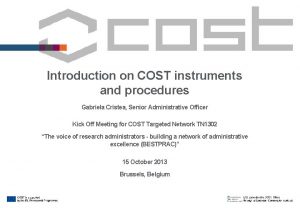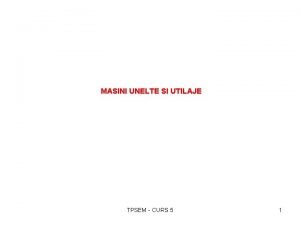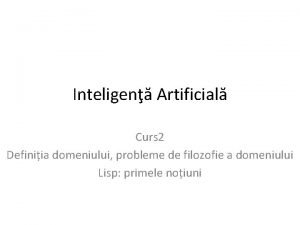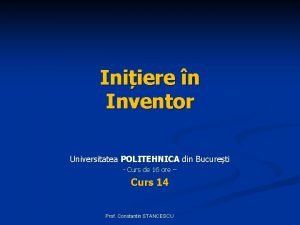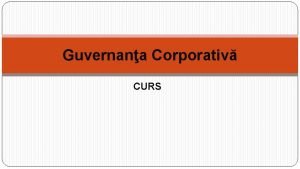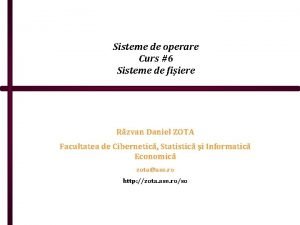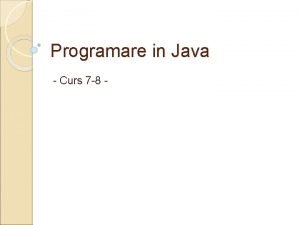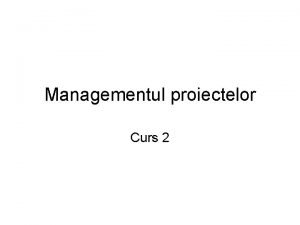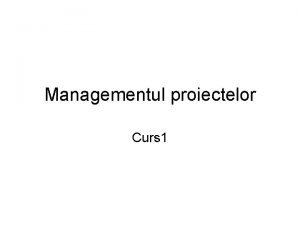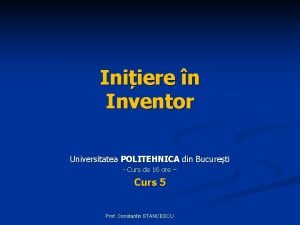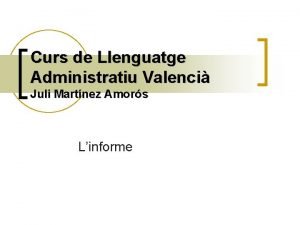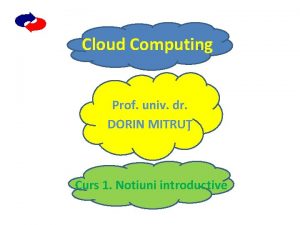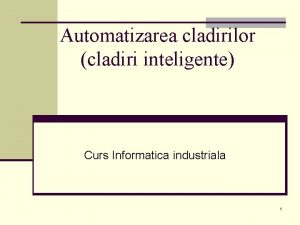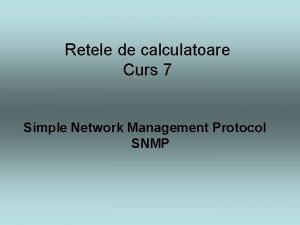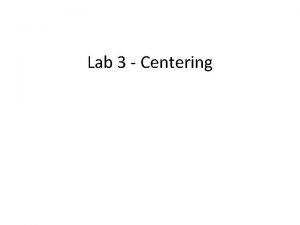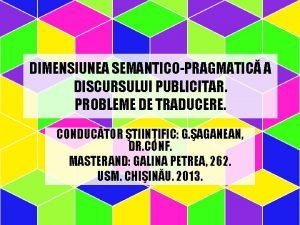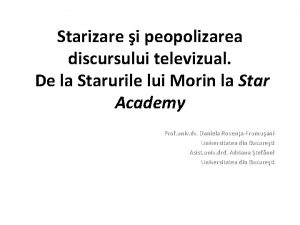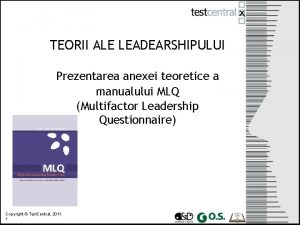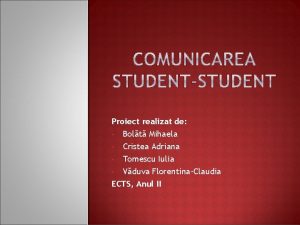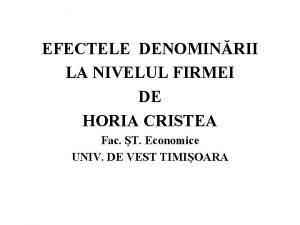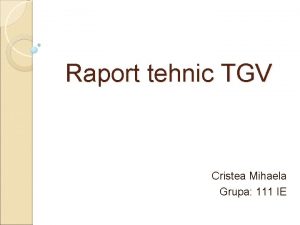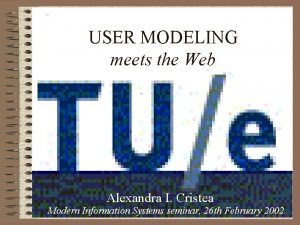Curs 7 Teorii ale discursului Centering Dan Cristea



















![Rule 1 observed a. Terry really goofs sometimes. Cf = ([Terry]) b. Yesterday was Rule 1 observed a. Terry really goofs sometimes. Cf = ([Terry]) b. Yesterday was](https://slidetodoc.com/presentation_image/6ff197cb02523ab0cb48c81095efc5ff/image-20.jpg)
![Rule 1 still observed a. Terry really goofs sometimes. Cf = ([Terry]) b. Yesterday Rule 1 still observed a. Terry really goofs sometimes. Cf = ([Terry]) b. Yesterday](https://slidetodoc.com/presentation_image/6ff197cb02523ab0cb48c81095efc5ff/image-21.jpg)
![Rule 1 disobserved a. Terry really goofs sometimes. Cf = ([Terry]) b. Yesterday was Rule 1 disobserved a. Terry really goofs sometimes. Cf = ([Terry]) b. Yesterday was](https://slidetodoc.com/presentation_image/6ff197cb02523ab0cb48c81095efc5ff/image-22.jpg)






- Slides: 28

Curs 7: Teorii ale discursului Centering Dan Cristea Selecţie de slide-uri prezentate în tutoriale (RANLP-03, Borovits, Sept. 2003; ICON-04, Hyderabad, Dec. 2004) şi conferinţe

Centering - a theory of local discourse coherence • Joshi, A. K. and Weinstein, S. , 1981: “Control of Inference: Role of Some Aspects of Discourse-Structure Centering“ • Grosz, B. ; Joshi, A. K. and Weinstein, S. , 1986: “Towards a computational theory of discourse interpretation” • Brennan, S. E. ; Friedman, M. W. and Pollard, C. J. , 1987: “A Centering approach to pronouns“ • Grosz, B. ; Joshi, A. K. and Weinstein, S, 1995: “Centering: A framework for modeling the local coherence of discourse” • Strube, M. and Hahn, U. , 1996: “Functional Centering“ • Walker, M. A. ; Joshi, A. K. and Prince, E. F. (eds. ), 1997: “Centering in Discourse“ • Kameyama, M. , 1997: “Intrasentential Centering: A Case Study“ • Poesio, M. , Stevenson, R. , Di Eugenio, B. and Hitzeman, J. 2004: “Centering: A Parametric Theory and Its Instantiations”

CT: goals of theory • explains why certain texts are more difficult to process than others • explains why we use the pronouns the way we use them • anchors a practical approach for anaphora resolution

A smooth discourse from (Walker, Joshi and Prince, 1997) a. Jeff 1 helped Dick 2 wash the car. b. He 1 washed the windows as Dick 2 waxed the car. c. He 1 soaped a pane. He in c. is Jeff because soaping can only be related to the washing event

A. . . smooth discourse less a. Jeff 1 helped Dick 2 wash the car. b. He 1 washed the windows as Dick 2 waxed the car. c. He 2 buffed the hood. He in c. is Dick, because buffing can only be related to the waxing event.

CT: focus helps to disambiguate pronominal anaphora from (Grosz, Joshi and Weinstein, 1995) 1. Susan 1 is a fine friend. 2. She 1 gives people the most wonderful presents. 3. She 1 just gave Betsy 2 a wonderful bottle of wine. 4. She 1 told her 2 it was quite rare. 5. She 1 knows a lot about wine.

CT explains the normality or oddness of some utterances from (Grosz, Joshi and Weinstein, 1995) a. Terry really goofs sometimes. b. Yesterday was a beautiful day and he was excited about trying out his new sailboat. c. He wanted Tony to join on a sailing expedition. d. He called him at 6 A. M.

This text has a defect… a. Terry really goofs sometimes. b. Yesterday was a beautiful day and he was excited about trying out his new sailboat. c. He wanted Tony to join on a sailing expedition. d. He called him at 6 A. M. e. He was sick and furious at being woken up so early.

This text has a defect… a. Terry really goofs sometimes. b. Yesterday was a beautiful day and he was excited about trying out his new sailboat. c. He wanted Tony to join on a sailing expedition. d. He called him at 6 A. M. e. He was sick and furious at being woken up so early.

This text repairs the proceeding a. Terry really goofs sometimes. b. Yesterday was a beautiful day and he was excited about trying out his new sailboat. c. He wanted Tony to join on a sailing expedition. d. He called him at 6 A. M. e. Tony was sick and furious at being woken up so early.

. . . And we can go on like this: a. Terry really goofs sometimes. b. Yesterday was a beautiful day and he was excited about trying out his new sailboat. c. He wanted Tony to join on a sailing expedition. d. He called him at 6 A. M. e. Tony was sick and furious at being woken up so early. f. He told Terry to get lost and hung up.

But here we have again a problem. . . a. Terry really goofs sometimes. b. Yesterday was a beautiful day and he was excited about trying out his new sailboat. c. He wanted Tony to join on a sailing expedition. d. He called him at 6 A. M. e. Tony was sick and furious at being woken up so early. f. He told Terry to get lost and hung up. g. Of, course he hadn’t intended to upset Tony.

But here we have again a problem. . . a. Terry really goofs sometimes. b. Yesterday was a beautiful day and he was excited about trying out his new sailboat. c. He wanted Tony to join on a sailing expedition. d. He called him at 6 A. M. e. Tony was sick and furious at being woken up so early. f. He told Terry to get lost and hung up. g. Of, course he hadn’t intended to upset Tony.

Finally, we are done! a. Terry really goofs sometimes. b. Yesterday was a beautiful day and he was excited about trying out his new sailboat. c. He wanted Tony to join on a sailing expedition. d. He called him at 6 A. M. e. Tony was sick and furious at being woken up so early. f. He told Terry to get lost and hung up. g. Of, course Terry hadn’t intended to upset Tony.

CT: the main lines • Applies to just one segment of discourse – refers to Grosz&Sidner´s Attentional State Theory • Sees the segment drawn up of adjacent utterances (sentences) • Discourse entities are called centers

Centers John gave Mary a flower. the realisation relation person 1 type = person name = John gender = masc person 2 type = person name = Mary gender = fem flower 1 type = flower number = sg

What is a center? John went to Mary‘s house the realisation relation person 1 type = person name = Mary gender = fem house 1 type = house number = sg He met her down the street. He found it down the street.

For each utterance, compute: - a list of forward-looking centers Cf(ui) = <e 1, e 2, . . . ek> ranking: subject > direct-object > indirect-object > others - a backward-looking center Cb(ui) = highest-ranked element of Cf(ui-1) that is realised in ui - a prefered center Cp(ui) = e 1

Rule 1: pronoun realisation • If some element of Cf(ui-1) is realised as a pronoun in ui, than so is Cb(ui) – it captures the intuition that pronominalisation is one way to indicate discourse salience – if there are multiple pronouns in a sentence, realising discourse entities from the previous utterance, than Cb must be one of them – if there is just one pronoun, then the pronoun must be the Cb
![Rule 1 observed a Terry really goofs sometimes Cf Terry b Yesterday was Rule 1 observed a. Terry really goofs sometimes. Cf = ([Terry]) b. Yesterday was](https://slidetodoc.com/presentation_image/6ff197cb02523ab0cb48c81095efc5ff/image-20.jpg)
Rule 1 observed a. Terry really goofs sometimes. Cf = ([Terry]) b. Yesterday was a beatiful day and he was excited about trying out his new sailboat. Cf = (he=his=[Terry], [the sailboat]) Cb = [Terry] c. He wanted Tony to join on a sailing expedition. Cf = (he=[Terry], [Tony], [the expedition]) Cb = [Terry] d. He called him at 6 A. M. Cf = (he=[Terry], him=[Tony]) Cb = [Terry]
![Rule 1 still observed a Terry really goofs sometimes Cf Terry b Yesterday Rule 1 still observed a. Terry really goofs sometimes. Cf = ([Terry]) b. Yesterday](https://slidetodoc.com/presentation_image/6ff197cb02523ab0cb48c81095efc5ff/image-21.jpg)
Rule 1 still observed a. Terry really goofs sometimes. Cf = ([Terry]) b. Yesterday was a beatiful day and he was excited about trying out his new sailboat. Cf = (he=his=[Terry], [the sailboat]) Cb = [Terry] c. He wanted Tony to join on a sailing expedition. Cf = (he=[Terry], [Tony], [the expedition]) Cb = [Terry] d. He called Tony at 6 A. M. Cf = (he=[Terry], [Tony]) Cb = [Terry]
![Rule 1 disobserved a Terry really goofs sometimes Cf Terry b Yesterday was Rule 1 disobserved a. Terry really goofs sometimes. Cf = ([Terry]) b. Yesterday was](https://slidetodoc.com/presentation_image/6ff197cb02523ab0cb48c81095efc5ff/image-22.jpg)
Rule 1 disobserved a. Terry really goofs sometimes. Cf = ([Terry]) b. Yesterday was a beatiful day and he was excited about trying out his new sailboat. Cf = (he=his=[Terry], [the sailboat]) Cb = [Terry] c. He wanted Tony to join on a sailing expedition. Cf = (he=[Terry], [Tony], [the expedition]) Cb = [Terry] d. Terry called him at 6 A. M. Cf = ([Terry], him=[Tony]) Cb = [Terry]

Rule 2: transitions Following (Grosz, Joshi and Weinstein, 1995) and (Brennan, Friedman and Pollard, 1987) Cb(u) = Cb(u-1) Cb(u) = Cp(u) CONTINUING SMOOTH SHIFT Cb(u) Cp(u) RETAINING ABRUPT SHIFT CON > RET > SSH > ASH

Rule 2: a point of discontinuity a. Terry really goofs sometimes. CONTINUING Cf = ([Terry]) b. Yesterday was a beatiful day and he was excited about trying out his new sailboat. Cf = (he=his=[Terry], [the sailboat]) CONTINUING Cb = [Terry] c. He wanted Tony to join on a sailing expedition. Cf = (he=[Terry], [Tony], [the expedition]) CONTINUING Cb = [Terry] d. He called Tony at 6 A. M. Cf = (he=[Terry], [Tony]) SMOOTH SHIFT Cb = [Terry] e. Tony was sick and furious at being woken up so early. Cf = ([Tony]) Cb = [Tony]

Rule 2: further analysis CONTINUING. . . d. He called Tony at 6 A. M. Cf = (he=[Terry], [Tony]) SMOOTH SHIFT Cb = [Terry] e. Tony was sick and furious at being woken up so early. Cf = ([Tony]) CONTINUING Cb = [Tony] f. He told Terry to get lost and hung up. Cf = (he=[Tony], [Terry]) RETAINING Cb = [Tony] g. Of, course Terry hadn’t intended to upset Tony. Cf = ([Terry], [Tony]) Cb = [Tony]

Centering hints on pronominal anaphora a. I haven’t seen Jeff for several days. Cf = (I=[I], [Jeff]) Cb = [I] b. Carl thinks he’s studying for his exams. Cf = ([Carl], he=[Jeff], [Jeff´s exams]) Cb = [Jeff] c. I think he? went to the Cape with Linda. from (Grosz, Joshi & Weinstein, 1983)

Centering explains why we understand he in unit c as Jeff b. Carl thinks he’s studying for his exams. Cf = ([Carl], he=[Jeff], [Jeff´s exams]) Cb = [Jeff] c. I think. Jeff he? went to the Cape with Linda. Cf = (I=[I], he=[Jeff], [the Cape], [Linda]) Cb = [Jeff] Cf = (I=[I], he=[Carl], [the Cape], [Linda]) RETAINING Cb = [Carl] ABRUPT SHIFT

Centering: any problems? • still a local theory (applies inside a segment) • BUT what is a segment? • ranking of Cf ellements – on what criteria (surface-order, syntactic role, functional (Strube&Hahn, 1996)) language dependant • null pronouns – Italian, Japanese, Romanian • intrasentensial centering (Kameyama, 1997) Centering - a parametric theory (Poesio et al, 2004)
 Ego psychologia
Ego psychologia Discurs public
Discurs public Factorii evolutiei
Factorii evolutiei Zasady według arrheniusa
Zasady według arrheniusa Valență
Valență Alexandra cristea
Alexandra cristea Prof cristea testul 20
Prof cristea testul 20 Neuropediatrik
Neuropediatrik Exercitii dislalie polimorfa
Exercitii dislalie polimorfa Gabriela cristea
Gabriela cristea Combination of two vowels
Combination of two vowels Cursuri de automachiaj bucuresti
Cursuri de automachiaj bucuresti Mașini unelte curs
Mașini unelte curs Curs inteligenta artificiala
Curs inteligenta artificiala Curs inventor
Curs inventor Curs guvernanta corporativa
Curs guvernanta corporativa Sisteme de operare curs
Sisteme de operare curs Epurarea apelor uzate curs
Epurarea apelor uzate curs Curs practic de java
Curs practic de java Curs data science
Curs data science Plan de lucru
Plan de lucru Tripla constrangere
Tripla constrangere Curs inventor
Curs inventor Curs de llenguatge administratiu
Curs de llenguatge administratiu Dorin mitrut
Dorin mitrut Pozitia orto si para
Pozitia orto si para Sisteme de automatizare curs
Sisteme de automatizare curs Curs sisteme de operare
Curs sisteme de operare Retele de calculatoare curs
Retele de calculatoare curs

